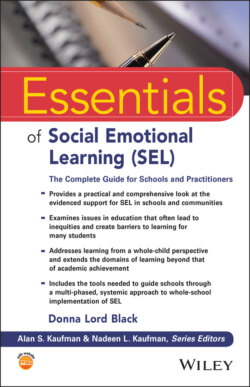Читать книгу Essentials of Social Emotional Learning (SEL) - Donna Lord Black - Страница 27
Establishing the Critical Areas of Competence
ОглавлениеThroughout the history of SEL, there have been ongoing challenges to understanding exactly what it is, despite the various definitions and descriptions provided in the literature. SEL has been described by many as a concept for which it is difficult to “wrap one’s head around.” As previously mentioned, this may partially be due to the differences in terminology being used to describe it, but it also is largely due to a lack of agreement about how it should be conceptualized, defined, and quantified. This ambiguity translates into a host of challenges, particularly in communicating the concepts and how they are connected to specific skills, but also in successfully obtaining resources and funding, and adequately translating research into practice, among others.
There are more than 100 SEL frameworks identified in the research, and each has been developed for specific purposes, but primarily to facilitate social and emotional development. Each framework employs its own language that is aligned to that framework’s goals, so terminology is often different for each framework. This makes contrasting and comparing frameworks extremely challenging and complicated. Additional frameworks continue to emerge each year, adding to the already cluttered and confusing landscape.
In an effort to add clarity and address some of these dilemmas, Harvard University’s Graduate School of Education undertook the Taxonomy Project. One of the outcomes of the project was the creation of a web‐based platform that showcases areas where SEL frameworks align and areas where they diverge (Jones, Bailey, & Nelson 2019). The project examined more than 40 SEL frameworks and the non‐academic domains covered by each framework. The frameworks were selected for inclusion in the project based on three criteria: (a) being representative of a wide range of disciplines, (b) being widely adopted, and (c) including descriptive skills, traits, competencies, strengths, mindsets, and/or attributes that were defined and could be coded (EASEL Lab, 2020).
One of the goals of the project was to enable users to compare the skills within each framework and across the different frameworks so they could then be connected back to evidence‐based practices. Since skills may be labeled differently across the various frameworks, the project was especially mindful of the need for clarity and transparency in defining the skills so that decisions about interventions and strategies could be better informed. In other words, through the work of the project, specific skills were identified for six different non‐academic domains, and the skills were then connected to those that may be labeled differently in the various frameworks. For example, under the cognitive domain, the skill of inhibitory control is identified as self‐management under the CASEL framework, but under the Building Blocks for Learning framework, it is identified as executive functions. Categorizing skills according to the six non‐academic domains allows the skills to be connected across the frameworks and eliminates confusion created by the various terms used to describe the skills. Consequently, practices can be better aligned with the scientific evidence that supports them.
